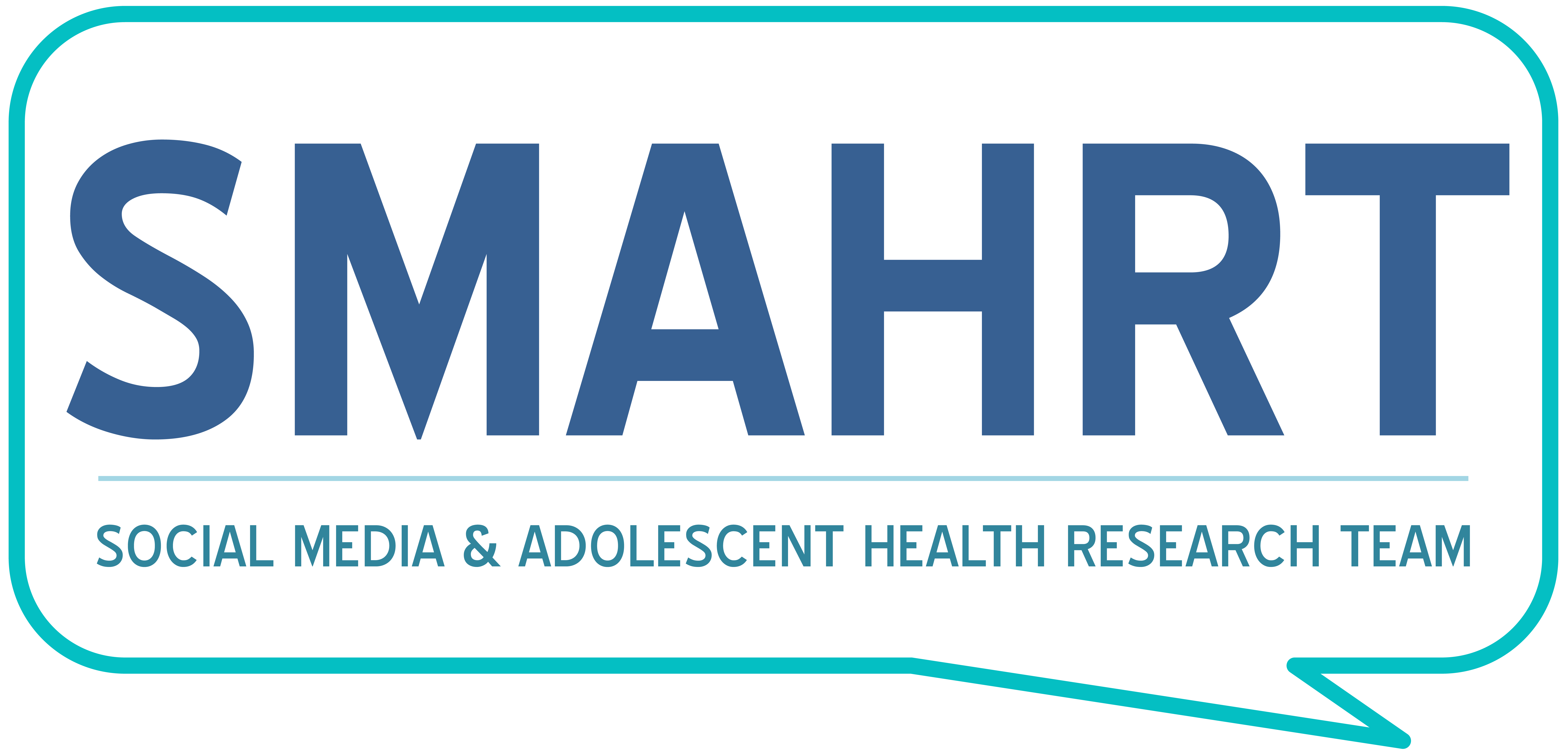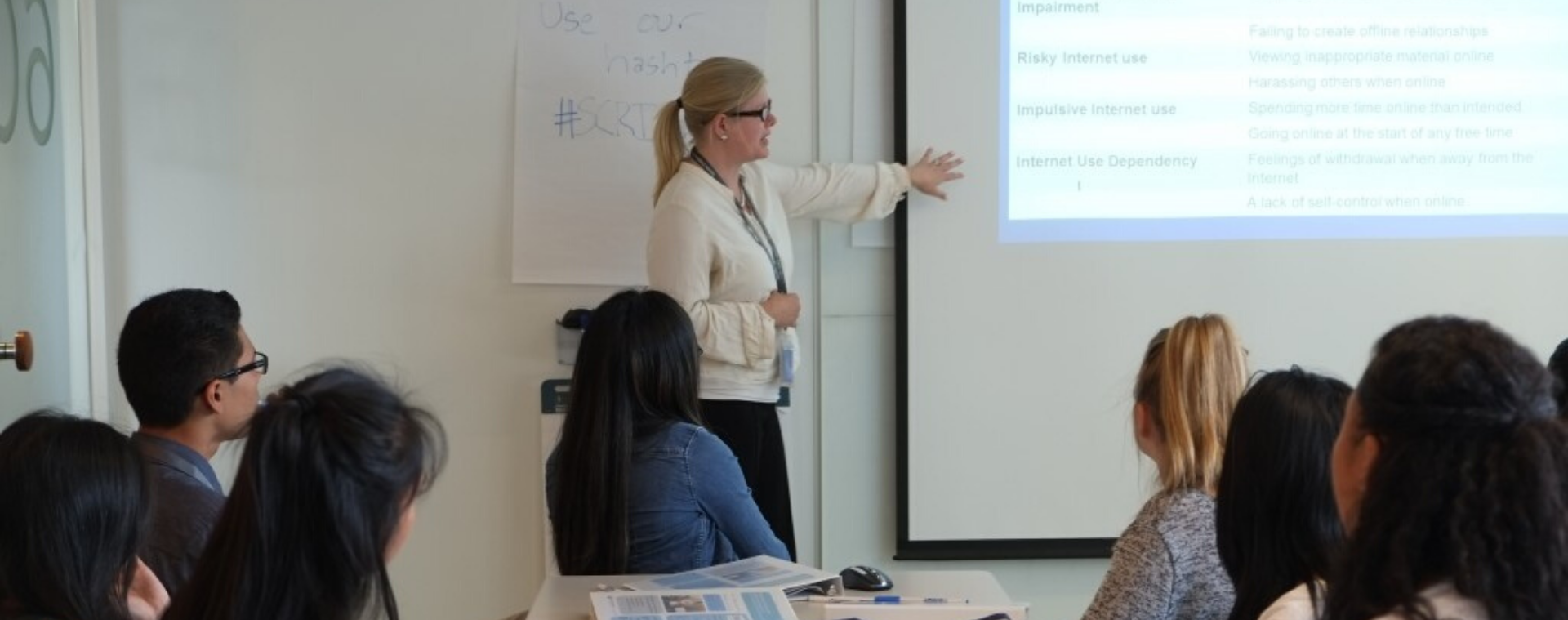Previous studies have found associations between consuming media, such as television and movies depicting tobacco and alcohol, and initiation of tobacco and alcohol use. Social media data is both created and consumed by users. It has been argued that sites such as Facebook may have greater influence than traditional media, as Facebook combines the power of interpersonal persuasion with the reach of mass media. The power of interpersonal persuasion cannot be underestimated among adolescents and young adults, for whom peers are the most important source of influence. Facebook, as a social networking site, provides a venue for peer interaction and social networking; both are recognized as contributors to behaviors such as substance use. These projects share the common goal of understanding displayed health behaviors on social media sites, and considering new ways to provide prevention and intervention programs using social media.
Social Media and Health Information Study (SMAHI) Phase 1: Using Focus Groups to Determine the
Optimal Intervention Approach
The purpose of the first phase of the R34 grant was to optimize the WEB-BASICS intervention for the community college population. To do this, the team held focus groups with community college students in order to incorporate their feedback into the intervention for use during Phase 2 of the study. In addition, we conducted a small pilot to test the feasibility of the SM-BASICS intervention delivery approach.
Social Media and Health Information Study (SMAHI) Phase 2: Investigating the Efficacy, Feasibility, and
Acceptability of a WEB-BASICS Intervention delivered via Social Media
The purpose of the second phase of the R34 grant is to test the efficacy, feasibility, and acceptability of
delivering a WEB-BASICS intervention in a community college population via Facebook and Instagram based on the initiation or escalation of a student’s social media alcohol references. To do this, Phase 2 is a randomized controlled trial featuring an active control condition and an intervention condition to test the updated intervention from Phase 1 in approximately 187 community college students from Seattle Central College, Columbia Basin College, South Seattle College, Gateway Technical College, and Blackhawk Technical College. To be included within the trial conditions, participants’ Facebook and Instagram were content coded each month for alcohol and marijuana references. If the participant met the criteria for obtaining an intervention, then they completed the previously validated, MI-based intervention (WEB-BASICS) and be prompted to complete follow-up surveys following the intervention at baseline, 1 month, 6 months, and 9 months. The data derived from Phase 2 will provide information about the early efficacy, feasibility and acceptability of a social media-delivered WEB-BASICS intervention in the community college population. Additionally, the findings will inform future studies based in this area.
Using Media to Investigate Mechanisms of Behavior Change: Aim 1
The purpose of this first aim of the R01 grant is to understand the relationship of alcohol and substance
references on Facebook to students’ attitudes, intentions, and behaviors over the course of college. This
information could contribute to improved screening for alcohol and substance use among this population and may ultimately reduce corresponding health problems. This study includes approximately 300 undergraduates from UW-Madison and University of Washington who began college in the fall of 2011. Participants complete yearly and prompted interviews regarding their substance use and social media use, and associations with social media displays are evaluated.
| Moreno, M. A., Kacvinsky, L., Pumper, M., Wachowski, L., & Whitehill, J. M. (2013). Associations between social media displays and event-specific alcohol consumption by college students. WMJ: official publication of the State Medical Society of Wisconsin, 112(6), 251. |
| Stewart, M. W., & Moreno, M. A. (2013). Changes in attitudes, intentions, and behaviors toward tobacco and marijuana during US students’ first year of college. Tobacco use insights, 6, TUI-S11325. |
| Moreno, M. A., D’Angelo, J., Kacvinsky, L. E., Kerr, B., Zhang, C., & Eickhoff, J. (2014). Emergence and predictors of alcohol reference displays on Facebook during the first year of college. Computers in human behavior, 30, 87-94. |
Using Media to Investigate Mechanisms of Behavior Change: Aim 2
The purpose of the second aim of the R01 grant is to develop a theoretical model to better understand the role that Facebook may play in impacting attitudes, intentions or behaviors regarding alcohol and substance use. Eventually, we hope to use this information to design targeted online interventions aimed at reducing risky health behaviors among young adults. Through the use of focus groups as well as a method known as concept mapping, college students’ input was used to construct a conceptual model that describes what aspects of Facebook have the greatest influence.
| Moreno, M. A., Kota, R., Schoohs, S., & Whitehill, J. M. (2013). The Facebook influence model: A concept mapping approach. Cyberpsychology, Behavior, and Social Networking, 16(7), 504-511. |
Previous studies in this core
Social media research methods publications
| Moreno, M. A., Kelleher, E., & Pumper, M. (2013). Evaluating displayed depression symptoms on social media sites. Social Networking, 2(04), 185. |
| Moreno, M. A., Goniu, N., Moreno, P. S., & Diekema, D. (2013). Ethics of social media research: common concerns and practical considerations. Cyberpsychology, behavior, and social networking, 16(9), 708-713. |
| Pumper MA, Yaeger J, Moreno MA. The use of social network sites in healthcare research: Here and abroad. College Student Journal. |
| Moreno, M. A., Grant, A., Kacvinsky, L., Moreno, P., & Fleming, M. (2012). Older adolescents’ views regarding participation in Facebook research. Journal of Adolescent Health, 51(5), 439-444. |
| Moreno, M. A., Egan, K. G., & Brockman, L. (2011). Development of a researcher codebook for use in evaluating social networking site profiles. Journal of Adolescent Health, 49(1), 29-35. |
Alcohol and substance use on social media
| Grant, A., Brown, B., & Moreno, M. (2013). The disparity between social drinking motives and social outcomes: A new perspective on college student drinking. College student journal, 47(1), 96-101. |
| Brockman, L. N., Pumper, M. A., Christakis, D. A., & Moreno, M. A. (2012). Hookah’s new popularity among US college students: a pilot study of the characteristics of hookah smokers and their Facebook displays. BMJ open, 2(6), e001709. |
| Moreno, M. A., Grant, A., Kacvinsky, L., Egan, K. G., & Fleming, M. F. (2012). College students’ alcohol displays on Facebook: Intervention considerations. Journal of American College Health, 60(5), 388-394. |
| Moreno, M. A., Christakis, D. A., Egan, K. G., Brockman, L. N., & Becker, T. (2012). Associations between displayed alcohol references on Facebook and problem drinking among college students. Archives of pediatrics & adolescent medicine, 166(2), 157-163. |
| Egan Katie G, Moreno MA. Alcohol and Stress: Undergraduate Males’ Facebook Profiles. Journal of Men’s Health. 2011 Mar 15. [Epub ahead of print] PMC3210384. |
| Moreno, M. A., Briner, L. R., Williams, A., Brockman, L., Walker, L., & Christakis, D. A. (2010). A content analysis of displayed alcohol references on a social networking web site. Journal of adolescent health, 47(2), 168-175. |
| Moreno, M. A., Briner, L. R., Williams, A., Walker, L., & Christakis, D. A. (2009). Real use or “real cool”: Adolescents speak out about displayed alcohol references on social networking websites. Journal of adolescent health, 45(4), 420-422. |
Depression and mental health on social media
| Moreno, M. A., Jelenchick, L. A., & Kota, R. (2013). Exploring depression symptom references on Facebook among college freshmen: a mixed methods approach. Open Journal of Depression, 2(03), 35. |
| Egan, K. G., Koff, R. N., & Moreno, M. A. (2013). College students’ responses to mental health status updates on Facebook. Issues in mental health nursing, 34(1), 46-51. |
| Whitehill, J. M., Brockman, L. N., & Moreno, M. A. (2013). “Just talk to me”: communicating with college students about depression disclosures on Facebook. Journal of Adolescent Health, 52(1), 122-127. |
| Moreno, M. A., Christakis, D. A., Egan, K. G., Jelenchick, L. A., Cox, E., Young, H., … & Becker, T. (2012). A pilot evaluation of associations between displayed depression references on Facebook and self-reported depression using a clinical scale. The journal of behavioral health services & research, 39(3), 295-304. |
| Moreno, M. A., Jelenchick, L. A., Egan, K. G., Cox, E., Young, H., Gannon, K. E., & Becker, T. (2011). Feeling bad on Facebook: Depression disclosures by college students on a social networking site. Depression and anxiety, 28(6), 447-455. |
| Egan, K. G., & Moreno, M. A. (2011). Prevalence of stress references on college freshmen Facebook profiles. Computers, Informatics, Nursing: CIN, 29(10), 586. |
Sexual behavior on social media
| Royer HR, Fernandez K, Moreno MA. Development of an interactive web-based STD self-management interventions for young women: implications of new media use. Computers, Informatics and Nursing. In press. |
| Moreno, M. A., Brockman, L. N., Wasserheit, J. N., & Christakis, D. A. (2012). A pilot evaluation of older adolescents’ sexual reference displays on Facebook. Journal of sex research, 49(4), 390-399. |
| Selkie, E. M., Benson, M., & Moreno, M. (2011). Adolescents’ views regarding uses of social networking websites and text messaging for adolescent sexual health education. American Journal of Health Education, 42(4), 205-212. |
| Moreno, M. A., Swanson, M. J., Royer, H., & Roberts, L. J. (2011). Sexpectations: Male college students’ views about displayed sexual references on females’ social networking web sites. Journal of pediatric and adolescent gynecology, 24(2), 85-89. |
| Moreno, M. A., Brockman, L., Rogers, C. B., & Christakis, D. A. (2010). An evaluation of the distribution of sexual references among “Top 8” MySpace friends. Journal of adolescent health, 47(4), 418-420. |
| Moreno, M. A. (2008). A randomized pilot intervention to reduce at-risk adolescents’ online risk behavior display on a social networking web site (Doctoral dissertation, University of Washington). |
Health behaviors displayed on social media
| Kacvinsky, L., & Moreno, M. (2014). Facebook use between college resident advisors’ and their residents: a mixed methods approach. College Student Journal, 48(1), 16-22. |
| Villiard, H., & Moreno, M. A. (2012). Fitness on facebook: advertisements generated in response to profile content. Cyberpsychology, Behavior, and Social Networking, 15(10), 564-568. |
| Moreno, M. A., Parks, M. R., Zimmerman, F. J., Brito, T. E., & Christakis, D. A. (2009). Display of health risk behaviors on MySpace by adolescents: prevalence and associations. Archives of pediatrics & adolescent medicine, 163(1), 27-34. |
| Moreno, M. A., Parks, M., & Richardson, L. P. (2007). What are adolescents showing the world about their health risk behaviors on MySpace?. Medscape general medicine, 9(4), 9. |

